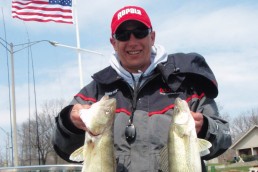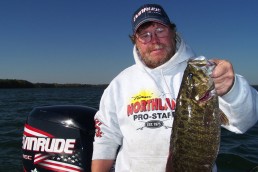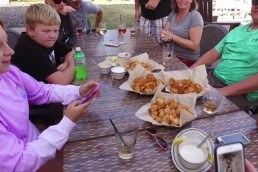Catch Walleyes in the Wind
SHARE THIS POST
The search for walleyes in the Upper Midwest and the Northwoods usually begins with an angler positioning his boat near rocky reefs or windy points and firing artificial lures or live baits at every likely looking piece of cover on the electronics. This is a tried and true tenet of walleye fishing—fish where the fish are. A couple of days in such places usually produces a bulging livewell and plenty of fillets. But on days when the fish are not where they’re supposed to be, where do you look for them? The chances are better than ever that they may be lurking in cover where many would least expect to find them: weed beds of northern lakes.
Not every type of weed bed here will hold populations. But what you want to look for initially is a wide, flat area not much more than 20 feet deep that’s full of cabbage weeds. This should be a field that covers several acres and drops off into deeper water. This area is a walleye hotel. The wide and flat areas give the fish plenty of locations to roam and search for food. They harbor all sorts of forage such as minnows, leeches, insects and other “bugs.” The deeper water also provides a sanctuary escape route to flee from predators.
Once you’ve found these weed beds and have determined that there are walleyes in it, how you catch them should be determined. There are three known tactics that can provide a solution.
The first involves a shallow-running crankbait that is cast out and retrieved over any submerged weeds. A minnow- imitating lure with lots of flash, vibration and rattle is best. Good choices are the Bill Lewis Rat-L Trap, the Rattlin’ Hot Spot and my favorite, the Rapala Rattlin’ Rap. Use a reel loaded with 8- or 10-pound-test Berkley FireLine too, which is strong enough to rip through the weeds.
First, make your cast out over the weeds and begin your retrieve immediately. As it comes in you want your lure to just touch the top of the weeds. If it hangs up, just give a quick tug on the FireLine to pop it free. This can happen when a vicious strike is occurring or is about to. This technique also works best with aggressive fish. Also, when the wind is creating the famous “walleye chop” and the sky is overcast, you know that those ‘eyes are going to be biting.
Are you enjoying this post?
You can be among the first to get the latest info on where to go, what to use and how to use it!
When you find weedline walleyes that are non-aggressive, you may want to try to tempt them into action with live baits. I have caught more walleyes with ’crawlers than any other bait. However, they aren’t my first choice for fishing the weedline walleyes. The reason is that the weed beds—in addition to holding desirable walleyes—contain thousands of bluegills and perch that will nip away at your nightcrawlers and drive you crazy. I begin with a fat minnow on a jig and look for irregularities in the weedline and just cast right into them. Let your lure begin to fall and just jig it back to the boat. Most of the time the strike will come as the bait is falling. When this happens, set the hook and get ready for a fight. When it comes, keep firm pressure on the fish and guide it out of the weeds. Walleyes rarely jump, but a big one will wallow in the weeds and twist your line in the vegetation if you’re not careful.
If the old standby jig and minnow fails to produce, there are several other live-bait setups such as the Lindy Rig, the Roach Rig or your own iteration of either. Recently, my companions and I trolled Spin-N-Glos behind Smile Blades on 3-foot snells behind bottom bouncers in the weeds of Houghton Lake in Michigan. Baited with lively leeches and trolled with small planer boards, we were then able to boat walleyes, northerns and largemouths and a few panfish. And this was on one of those windy, overcast days with air temperatures not even reaching 50 degrees.
Weedline fishing for ‘eyes is as much of a challenge as it is for any other species. And while we don’t think of walleyes as weed-dwellers, that is where they can be found, especially on the windy days. This year has had many exceptionally windy days. I surely hope it lets up before I head to Ontario. But if it doesn’t, I’ll be ready. Follow these tips for more walleyes in the boat this year in the wind.
https://midwestoutdoors.com/full-slate-great-fall-walleye-patterns/
MWO
SHARE THIS POST
Did you enjoy this post?
You can be among the first to get the latest info on where to go, what to use and how to use it!
John Bennett
John Bennett is a retired history teacher, historical re-enactor, father and grandfather. As a four-season outdoorsman, his passion is waterfowl hunting and fishing for smallmouth bass. He lives in Ohio and spends quite a bit of time in his primitive log cabin, which he built.



